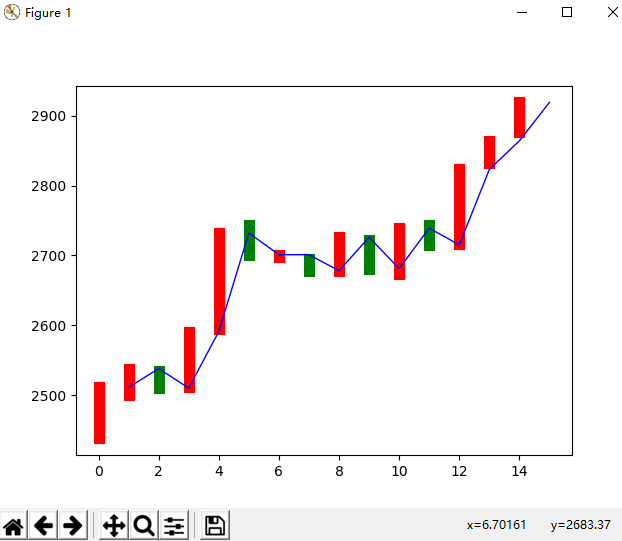#!/usr/bin/python
# -*- coding:UTF-8 -*-
# author:cxx time:2019/8/28 0028
import tensorflow as tf
import numpy as np
import matplotlib.pyplot as plt
date = np.linspace(1,15,15)#在1-15之间生成15个间隔相同得数字作为十五天的日期
endPrice = np.array([2511,2538,2510,2591,2732,2701,2701,2678,2726,2681,2739,2715,2823,2864,2919])#当日股票收盘时(下午三点)的价格
beginPrice = np.array([2438,2500,2534,2512,2594,2743,2697,2695,2678,2722,2674,2744,2717,2832,2877])#当日股票开盘时(上午九点)的价格
print(date)
plt.figure()
for i in range(0,15):
dateOne = np.zeros([2])#生成一个初始值为0的长度为2的一维数组-->开盘收盘的日期
dateOne[0] = i
dateOne[1] = i
priceOne = np.zeros([2])#价格
priceOne[0] = beginPrice[i]#当日开盘价格
priceOne[1] = endPrice[i]#当日收盘价格
if beginPrice[i]>endPrice[i]:
plt.plot(dateOne,priceOne,'g',lw=8)
else:
plt.plot(dateOne,priceOne,'r',lw=8)
# A(15x1)*w1(1x10)+b1(1x10) = B(15x10)
# B(15x10)*w2(10x1)+b2(15x1) = C(15x1)
#A 输入层
dateNormal = np.zeros([15,1])
priceNormal = np.zeros([15,1])
for i in range(0,15):
dateNormal[i,0] = i/14.0#归一化
priceNormal[i,0] = endPrice[i]/3000.0
x = tf.placeholder(tf.float32,[None,1])#placeholder用于占位
y = tf.placeholder(tf.float32,[None,1])
#B 隐藏层
w1 = tf.Variable(tf.random_uniform([1,10],0,1))#返回值在0-1之间的一行十列的矩阵
b1 = tf.Variable(tf.zeros([1,10]))
wb1 = tf.matmul(x,w1)+b1
layer1 = tf.nn.relu(wb1)#激励函数relu
#C 输出层
w2 = tf.Variable(tf.random_uniform([10,1],0,1))
b2 = tf.Variable(tf.zeros([15,1]))
wb2 = tf.matmul(layer1,w2)+b2
layer2 = tf.nn.relu(wb2)
loss = tf.reduce_mean(tf.square(y-layer2))#y 真实值 layer2 计算值
train_step = tf.train.GradientDescentOptimizer(0.1).minimize(loss)#梯度下降方法,参数:学习率
with tf.Session() as sess:
sess.run(tf.global_variables_initializer())
for i in range(0,50):
sess.run(train_step,feed_dict=({x:dateNormal,y:priceNormal}))#训练出优化的w1,w2,b1,b2的值
pred = sess.run(layer2,feed_dict={x:dateNormal})
predPrice = np.zeros([15,1])#最终预测价格
for i in range(0,15):
predPrice[i,0]=(pred*3000)[i,0]#还原归一化后的价格
plt.plot(date,predPrice,'b',lw=1)
plt.show()
效果图:

